
Many 30-35 people complain of back pain.The cause of these pain can be the disease of the spine.Osteochondrosis is a disease that occurred in people in the middle, but more than 40 years later is found in patients.
Osteochondrosis - What is this disease and what is its danger?
This term means a doprophic process of cartilage and subject bone tissue.In modern medical practice, osteocondrosis is called degenerative-dystrophic disease of spine and intervertebral disks playing a shock absorption.The danger of the disease is almost possible without the restoration of the impacted disc and without the proper treatment.
Osteochondrosis is a general disease?Statistics are not happy.About 85% of the world's population suffers from this disease.
This disease is the most common shape among all diseases affecting the spine.And after the dissemination of the cardiovascular system immediately.
The essence of the disease
So osteocondrosis - what is it?This is a chronic disease that affects the joints, in most cases spine.
The spinal column consists of 24 vertebrae.It is a disk between the two vertebraes, the purpose of this is to soften the loads and wear.
In normal condition, the disk is quite elastic and can withstand significant loads.The center of the disk has a pulpation core with a lot of water.For some reason, the basic hydrophilitability is losing.
As a result, disk delays, decrease in altitude and deformation.In the next stages, bone tissue growth occurs with the emergence of growth - osteophitis that squeeze the peripheral nerves and spinal cord.This is what is the osteocondrosis of the spine.
Causes of pathology
Although osteocondrosis is a very common disease, the reasons for the development of pathology are not completely established.

The main factors are taken into account:
- Excess burden of spine;
- Injuries;
- Professional harmfulness - a disturbing, inactive pose weight lifting or work that lasts for a long time;
- Body weight anymore;
- hereditary;
- the violation of the posture.
Osteochondrosis is developing almost a degree or other elderly, and one of the processes of the body's aging.
Development stages, forms and signs of the disease
Experts distinguish 4 stages of the disease:
- Stage 1- transfer the core of the disk;
- Stage 2- the formation of cracks on the wheels of the cartilage and the instability of the vertebral part;
- Stage 3- The root of the spine is a complete rip of the disk of the core, the roots of the spinal cord are possible;
- Stage 4- The rough changes are not only on the intervertebring disk, but also around.
The main symptom of the disease is pain.Can be sharp with high intensity or dumb, medium manifestation.
In addition to pain, there are:
- painful tension of rear muscles;
- Dental numbness in arm and legs;
- restriction of the volume of actions;
- weakness in the muscles of the limbs;
- The tenderness of arm and feet;
- Sudden dizziness.
These are common manifestations for all pathology.Depending on the spine, which is localized, the three forms of the disease with characteristic symptoms are different.
Table # 1.Forms of osteocondrosis and unique symptoms:
| The form of the disease | Symptoms |
| Osteocondrosis in the neck | Changes in this department cause blood vessels and microcirculation.Therefore, a person has permanent dizziness.Sometimes it causes this fainting.There are noises in the ears and there is a whipping of colored spots in front of the eyes. |
| Osteocondrosis in the thoracic vertebra | Sharp chest pain is observed with this form of disease.The disease can cause the intercostal neuralgia forward and can aggravate the course of heart pathologies. |
| Osteocondrosis in the Lombber region | The pain in the low-back pathological, gluteal region is reduced by a decrease in tone of ikr.There can be a complication that is an accompanied by pain spread throughout the foot. |
According to the pathology of virtebral disks, a large number of disorders in the body include: pinches of nerves, swelling, blood circulation and fibrosis of the surrounding tissues.These changes make the diagnosis that complicates the diagnosis and causes various symptoms that determine the relevant treatment without examination.
Clinical manifestations
The symptoms of the disease depend on where the lesion is largely located.In the following parts, we consider the symbols characteristic of each assortment of the disease.
Cervical department
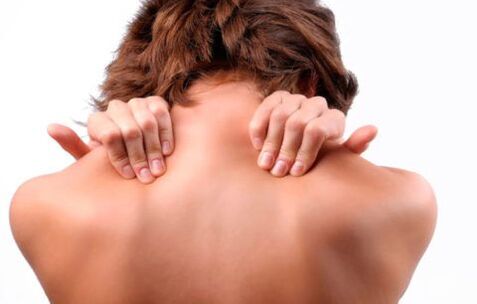
The main symptoms of cervical spinal damage are:
- Pain on anxiety, neck and shoulders;
- muscle hypotone;
- increased sweating;
- numbness of fingers;
- violation of coordinated actions;
- headache, dizziness;
- Hearing and vision problems;
- Hypertension.
One of the following syndromes may develop by progress of the disease and damage to nearby veins and nerves:
- vertebral artery;
- heart;
- hypertension;
- root;
- cervical migraine.
Violation of the blood circulation in this hypox of vertebral artery and brain tissues is the dangerous consequences of osteocondrosis.
This syndrome shows itself:
- System / Periodic dizziness;
- the weakening of vision;
- partial or full hearing loss;
- Sometimes - do not lose.
Important!Neurological manifestations of osteocondrosis of the spine should often distinguish the brain atherosclerosis, DEP and other pathologies.
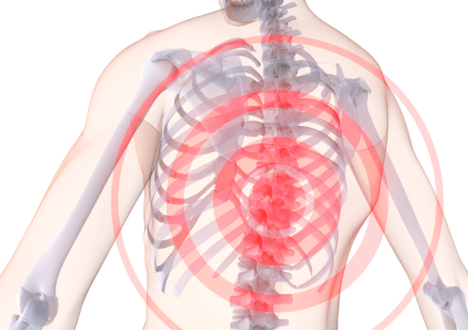
Torakal region
Compared to other forms of the disease, thorakal osteocondrosis is less pronounced.
Among the symptoms:
- Pain in the chest, grows at night or stretching in a position;
- anxiety, the feeling of squeezing between shoulder blades;
- Strengthen pain while breathing deep.
If the disease is not treated, it will move to nearby nearby and nerves.
This localization may have signs of the development of the consequences of the osteocondrosis of the spine:
- In some areas, the numbness of the skin, "goosebumps" a creeping feeling;
- Skin itch, burning;
- the cooling of the limbs;
- the fragility of nails;
- Dry skin pronounced;
- Pain along the esophagus and farenx;
- Disorders of the gastrointestinal tract.
In addition, the chest localization of the disease is characterized by two special symptoms - dorsago and dorsalgia.
Dorsago is a sudden, sharp and very dense chest pain, "Torakal turns".In the same position, it can last a long time in monotonous work.
Pay attention!The pain during breastfeeding is so severe so that patients are even afraid to get an additional inhalation.
Dorsalgia is less dense but monotonous painful feelings that can last until 2-3 weeks.Deep breathing, strengthens with trends.
Department
Osteocondrosis of the lower part of the spine, that is, it is a leader to broadcast.
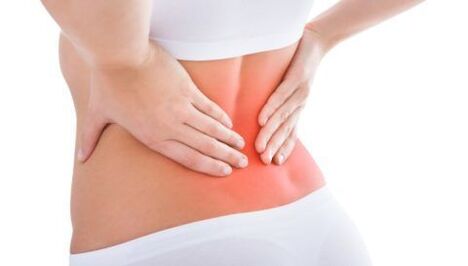
Among its characteristic symptoms:
- Boring, more back pain, radiation in the leg;
- Strengthening the body's position, cunning, cough and weights trying to lift the weight;
- Sub-protection permanent muscle spasm;
- The lights under the bottom;
- Node, hips, legs, sensitivity to the skin of the feet;
- the feeling of crawling goosebumps in the lower extremities;
- Dry, skin peeling.
Sacral department
Osteocondrosis of the sacral spine is extremely rare in isolated and generally "continuation" of low waist damage.
This explains the features of his symptoms:
- back pain, as well as the sealing nerve;
- Sharp "shelters" of all legs;
- a feeling of unpleasant disturbance behind the thigh;
- the numbness of the lower extremity;
- Unstable symptoms of parez, as well as disabled motor activity.
Important!Osteocondrosis of the low spine can lead to such dangerous complications for the supply of the spinal cord and compression.
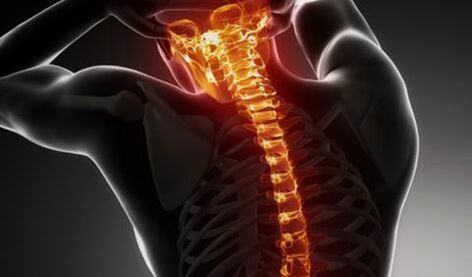
Total osteocondrosis
A common form of all parts of the spine or osteocondrosis is the most severe version of pathology.According to the width of the defeat, its photo can be extremely different and covers almost all symptoms described above.
Diagnostic methods
The appearance of any of the above-mentioned complaints requires an appeal to the medical institution: the patient should investigate the patient.The diagnosis of osteocondrosis should be complex and very comprehensive.
The standard instructions include the following stages:
- Complaints and a collection of Anamnesis.
- Clinical inspection.
- X -Ray exam.
- Modern methods (CT, MRI).
Conducting the patient, a doctor needs to be found:
- concerned the patient;
- What is the location of the most commonly used unpleasant feelings;
- What are their intensity and duration;
- which causes strengthening;
- helps to cope with the pain.
Important!Make sure you are concerned about such complaints and get any treatment before.
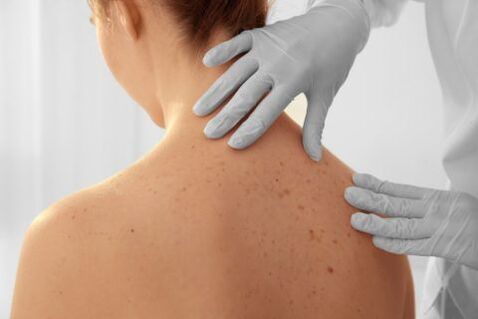
Evaluates a specialist during a clinical inspection:
- The position, gait, active and passive movements of the patient's body;
- skin imperfections, redness, peeling;
- symmetry of healthy and sick parts of the body;
- the presence of muscle spasm;
- the irradiation of pain;
- The presence of pain, temperature and other types of sensitivity.
Every waist is also studied for better visualization during radiography.Images are directly, laterally and (according to indicators) are conducted in two oblique forecast.X-ray classification of osteocondrosis of the Zeaker's spine is used to evaluate the scene and violence of degenerative-dedosic changes.
Table: Stages of Osteocondrosis of X-Debt:
| Stagnate | Description |
| I (+) | Unaware changes in the Lordose in a small number of segments |
| II (++) |
|
| III (+++) | Expressed the changes, significant contraction of intervertebral holes |
| IV (++++) | Significant contractions of intervertebral holes, massive exhthtosis, often irreversible changes |
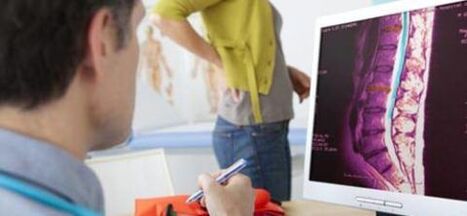
The patient can be assigned more modern tests-CT with enough data content
Treatment
Initially, the doctor explains what osteocondrosis will be treated.Talks from the collection of measures to be fulfilled for a long time.
The therapy of the disease is taken into account the stage.During the initial period of the disease, physiotherapy, physiotherapy exercises are shown.However, as the dystrophic process progresses, various orthopedic devices should be used to immobilize the spine.Drug treatment is also necessary.
Surgical intervention is shown in the neutralism of complications and conservative treatment.
The drugs
The most important tasks of pharmacological drugs are relief of pain, eliminates the inflammation of nerve roots, restoring the structure of the cartilage, the development of blood circulation and nutrition, ceases to develop pathology.There are several drugs that can be determined in this situation.
They are represented in pharmacies, various forms and in various fields.The price of medication can be different and you can always choose the most affordable.
Table № 2. Medicines used in osteocondrosis conservative therapy:
| Pharmacological group | Therapeutic effect | Rules of use |
| Chondroprotants | Slow the processes of cartilage, contribute to its recovery. | Take 1 capsule for a month.If necessary, the course of treatment is repeated. |
| Nsaid | It has anesthetic effect, reduces inflammatory process. | Take a tablet for pain.Severe pain, the medication is used in murderic injections. |
| B vitamins | Improves the permeability of nervous pulse, restores microcirculation in the field of cartilage. | Intramuscular treatment is carried out in injections. |
| Musorakants | Relaxes the muscles, eliminates tension, facilitates the pain. | Take a tablet 2 times a day. |
The drug is determined by the doctor's statement.Self-existence may be ineffective and in some cases damage.
Physiotherapy for osteochondrosis
What do you need to do with osteocondrosis, except for drugs, to accelerate the recovery?One of the most effective methods of treatment of this disease is physiotherapy.
His advantage is the voter effect in the focus of the disease.Reduce pain, eliminating inflammation and contribute to physiotherapy to increase common immunity.With their help, muscles are comfortable, metabolic processes and blood circulation normal.
Successfully used for osteocondrosis:
- magnetotherapy;
- Laser therapy;
- Shock wave therapy;
- quartz;
- Electrophorez;
- The effect of low frequency electric currents.
Physiotherapy does not exercise whether the patient is in critical condition, the disease, oncological diseases and mental disorders. In other cases, physiotherapy has a useful impact on the recovery process, increases the impact of drugs, which reduces their doses.
In other cases, physiotherapy has a useful impact on the recovery process, increases the impact of drugs, which reduces their doses.
Medical physics education
During the sharply period of the disease, physical education classes are prohibited.Upon eliminating this period, the doctor sets the therapeutic exercises that developed with the instructor individually for each patient.
With the help of the trainings, the muscle corset is intensified, which prevents the curvature of the spine and allows the load in the spine correctly and evenly.Permit the spine in higher concentration compared to the lack of constant physical force, drugs, spine.
We need to deal with an experienced instructor management and carefully watch their situation.Exercise should be stopped with anxiety and severe pain.
Prevention
It will be useful to think about what osteocondrosis is and to know what his consequences are.
Preventive measures are very simple, easy to take care of their health:
- Prevention of injuries;
- Regular physical education (swimming is very useful);
- maintain normal weight;
- Do not load the spine;
- to control the correctness of the posture;
- not to be in a long-term position;
- Avoid sudden movements while raising weight.
When performing these rules, the remission period will be long.
Osteochondrosis is a very serious illness.However, it is possible to stop the destructive effects, looking for a doctor and adequate treatment in time.
Questions to the doctor
Pain in the neck
Hi, please say.I'm 24 years old.The pain in his neck for the past few months, the back of the head (sometimes whiskey, eyes).I see a powerful crisis in the neck, hands, tongue and sky of heaven and numbness.
I suspect osteocondrosis because both mother and younger grandmother suffer from similar symptoms.Where to start the exam?And another question: Can I go to aerobics?
Correct the doppler of the R-scheme (CT) shop and head and neck vessels.You have probably developed vertebral artery syndrome against the background of cervical osteocondrosis.An additional plan for diagnosis and treatment can only be compiled after achieving the results of these tests.
It is better not to visit aerobics yet.
Lomber Osteocondrosis
For seven years, I have been tormented with the lower back, osteochondrosis is almost every 2-3 months.Injections and tablets help shortly and then the pain comes.I work as an postman, it becomes difficult.I put a disability?
Hello!The decision on the award of the Disability Group is made on the basis of a comprehensive study of your situation by ITU.You must first contact the therapist and pass the exam.
As a rule, a disability group with a lumbar osteocondrosis is not shown.Its award is possible with the development of complications (protrusions, intervertebral hernia, etc.).But I still repeat, everything is individual here.

























